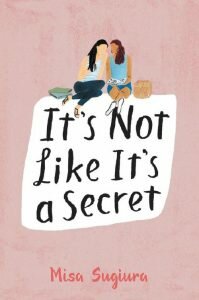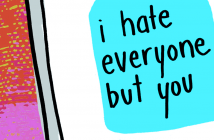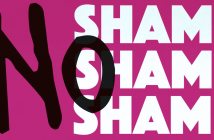 Described as charming and bittersweet, It’s Not Like It’s a Secret by Misa Sugiura deals with the messy parts of new relationships, race relations between communities of color, and all the things that come after coming out.
Described as charming and bittersweet, It’s Not Like It’s a Secret by Misa Sugiura deals with the messy parts of new relationships, race relations between communities of color, and all the things that come after coming out.
Sana Kiyohara has too many secrets. Some are small, like how it bothers her when her friends don’t invite her to parties. Some are big, like that fact that her father may be having an affair. And then there’s the one that she can barely even admit to herself — she might have a crush on her best friend.
It’s Not Like It’s a Secret is available now.
What can readers expect from It’s Not Like It’s a Secret?
It’s been pitched as To All the Boys I’ve Loved Before meets Simon vs The Homo Sapiens Agenda, which I like to think means that it’s relatively light and romantic and even funny, but also thoughtful, in that it delves into some social and personal issues.
Novels often go through multiple iterations before they make it to the bookshelves in our favorite indies. How much did It’s Not Like It’s a Secret change from the first time you had the idea, to current copy?
The basic premise remained constant: Japanese American daughter of immigrants falls in love with a Mexican American girl and comes to terms with the intersections of her ethnicity and her sexuality. The other characters and the basic plot elements like the poetry notebook, Sana’s dad’s affair, and Sana’s tensions with Jamie’s friends, have also remained the same. Good representation is very important to me, so my editor and I had a number of sensitivity readers look at my manuscript at various stages. I worked hard to incorporate all of their suggestions — I hope I did them justice!
Sana, the main character, moves from a more conservative town where she was the only Japanese person in her school, to California where there are other Asian students and it’s okay to be openly queer. What inspired you to write this particular experience?
Before I had a specific premise for my book, I knew that I wanted to write about a queer character. I checked out every contemporary YA book I could find in my library with LGBTQ+ protagonists, and discovered that nearly all of them were about white kids struggling to face angry family members and bigoted communities. While those narratives are important, I felt like they didn’t reflect the reality that I saw here in Silicon Valley, where being LGBTQ+ is mostly seen as no big deal. I knew several kids who were happily, comfortably out of the closet, at least at school. So I decided to write a book that showed the world that yes, there are stories and places where being queer is just part of life, rather than an Epic Struggle. I don’t mean to dismiss other experiences or to imply that there’s no LGBTQ+ discrimination in California, or that we’re done with the fight. But I think it’s important to have narratives besides the struggle narrative out there.
As for the Asian kid from a conservative town moving to a place where a full third of the students are Asian, that was inspired by an experience I had in high school. A Chinese American girl from my history class introduced me to a some of her friends from Chinese church youth group one day, and it blew my mind. They laughed about little things that came with being children of Asian immigrants—things that I had spent my whole life ashamed of, that had made me feel isolated and alone. They had this ethnic solidarity that I’d never experienced before, and I just drank it up.
Throughout the novel, you deal with racial relations between Latinx and Japanese people, mainly Sana, her love interest Jamie, and their respective friends. Can you tell us about why you chose to include these issues in your novel?
Again, it stems from not seeing my reality in the books that were available when I began writing, and from wanting to show the world that there are other ways of looking at things.
There are some great, important novels about kids of color and the challenges they face, but those challenges come almost exclusively from the white community. From what I saw as a teacher in the Bay Area, there’s a lot of interethnic/interracial tension between communities of color as well.
Once I chose Jamie as Sana’s crush, I didn’t really have a choice about exploring issues of race. I just imagined what each kid in the book would think about the other ones, and the unfortunate reality is that lots of ethnic minority kids are prejudiced and even racist when it comes to other ethnic minorities. I wanted to raise questions about that — wanted to ask about stereotypes, and about the extent to which we fit them. I wanted to examine where our misunderstandings come from, and how we can move through and beyond them.
[ctt template=”8″ link=”cfp45″ via=”no” ]”I wanted to write a character that queer Asian girls could read about and feel a jolt of recognition.“[/ctt]Why was it important to you to include Japanese and queer representation in your novel?
I just didn’t see Asian American characters in YA who were queer. Actually, that’s not true. There was one boy. But I wanted to write about a girl, and I didn’t see any queer Asian girls at all. I wanted to write a character that queer Asian girls could read about and feel a jolt of recognition. Obviously, Sana’s experience can’t stand in for every Asian lesbian’s experience. There are Asian girls who are the polar opposite of Sana, who are tougher or funnier or louder. And hopefully someone will write about those girls, too.
What’s next for you?
I’m working on another contemporary novel set in Silicon Valley. It’s still in the drafting stage, so I can’t say a whole lot about it for sure, but it has to do with our roots and our family and community histories, and the extent to which those histories can or should influence how we see ourselves, and how we treat each other today. There’s friendship, flowers, social activism, and, of course, romance!




